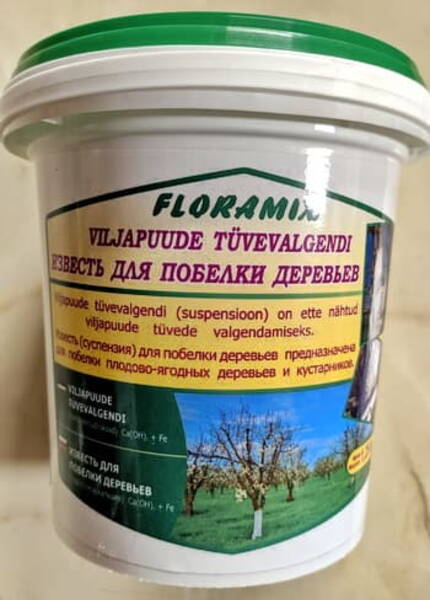Whitewash for fruit trees based on lime and iron sulfate.
Designed to protect against sunburn, partly against pests and diseases, as well as to prevent the appearance of mosses and lichens.
Stir the powder in approximately 1.5 liters of water until a homogeneous viscous-viscous mass is obtained. Let it sit for another half hour until completely swollen (if necessary, add a little more water to obtain an “easy-to-apply” consistency with a brush). Unused solution can be used in subsequent years by storing it in an airtight container.
Whitewash composition: slaked lime, clay, plasticizer, iron sulfate.
Warning: the presence of lime may irritate the skin, so wear water-repellent gloves. If the solution does get on your skin, rinse the area with plenty of water.
* Bark diseases generally begin with spring sunburn. They usually appear as pinkish spots on the bark. To avoid this, you need to whiten the trunks not in the spring, but also in the fall, so that they are protected from the bright March sun reflected by the snow. If the whitewash has faded by spring, touch it up as early as possible, at an air temperature of at least +6°C.
Instead of whitewashing, you can tie the trunks with strips of torn sugar bags, since they are made of fiberglass and are too tough for mice.
Whitewashing a tree according to the formula is considered conditionally sufficient: the entire trunk + 1/3 of the length of the lower skeletal branches. For mature trees (again, the average effective) whitewash height is considered to be 1.5-1.8 m, and experienced gardeners generally try to whitewash their pets as high as possible - up to 2 meters or more.
It is no longer uncommon to see garden plots where fruit trees flaunt a white limestone robe to the very tops. It turns out (almost like in sports) - the winner is the one who has the whitewash "Higher, Stronger and Whiter!"
6 rules for whitewashing.
Regardless of what you choose - lime or water-soluble paint (water-based, acrylic), the general rules for whitewashing must be followed in any case:
1. Trees can only be whitened in dry weather.
2. The air temperature should not be lower than -5°C (otherwise there is a high probability that the whitewash will lie on top of the ice and then simply flow down with it during the thaw).
3. You need to paint and whiten not only the trunks, as many do, but also the skeletal branches, since they are also susceptible to burns and frost damage.
4. Whitewashing should be done in autumn or winter (before mid-January). Sunburn and frostbites usually appear in February - March, so you need to catch them before this time. Spring whitewashing does not have a protective function - it is intended solely for aesthetic purposes.
5. Young seedlings of the current year cannot be whitened: premature whitening will slow down their future development. You can whiten them only from the second, or even better, from the third year of life in the garden.
6. Before whitewashing, the trunk and branches must be cleared of old and loose bark (which is best burned), mosses and lichens. And cover all wounds with garden varnish.
* An alternative whitewashing method.
European gardeners very often use not lime or paint, but a mixture of clay and cow dung with the addition of ash.
This is a very reasonable solution, since the clay perfectly protects the trunks from the sun, frost and strong wind, but at the same time does not clog the pores on the bark, allowing the plant to breathe fully, and mullein glues the clay and prevents it from falling off (it also contains nutrients and bioactive elements. You can add a little lime and iron sulfate to this mixture, which will be a good prevention against diseases. This whitewash has an unusual yellowish-light green tint and looks very aesthetically pleasing on the trunks.
Our advice: if you do whitewashing in the spring, be sure to add an insecticidal preparation based on pyrethroids (for example, the "Iskra" or "Inta-Vir" tablet) to the solution, which will protect the trees at the very beginning of the sap flow and from overwintered pests.











